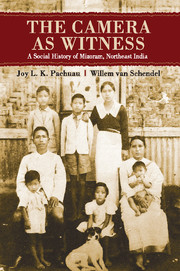Book contents
- Frontmatter
- Contents
- List of Figures
- List of Maps
- Acknowledgements
- I Becoming Mizo
- 1 Introduction
- 2 Coming into View: The First Portraits
- 3 Adjusting Mizo Culture
- 4 Domesticating a New Religion
- 5 Getting Educated
- 6 Controlling the Hills
- 7 The Trouble of Travel
- 8 First Stirrings of the Market Economy
- 9 Mizos in the World Wars
- 10 Mizo Visual Sensibilities
- II Mizoram in the New India
- III Visions of Independence
- IV Mizo Modernities
- Copyrights and Sources
- Glossary
- Bibliography
- Index
9 - Mizos in the World Wars
from I - Becoming Mizo
Published online by Cambridge University Press: 05 May 2015
- Frontmatter
- Contents
- List of Figures
- List of Maps
- Acknowledgements
- I Becoming Mizo
- 1 Introduction
- 2 Coming into View: The First Portraits
- 3 Adjusting Mizo Culture
- 4 Domesticating a New Religion
- 5 Getting Educated
- 6 Controlling the Hills
- 7 The Trouble of Travel
- 8 First Stirrings of the Market Economy
- 9 Mizos in the World Wars
- 10 Mizo Visual Sensibilities
- II Mizoram in the New India
- III Visions of Independence
- IV Mizo Modernities
- Copyrights and Sources
- Glossary
- Bibliography
- Index
Summary
It is hard to imagine the rapidity with which Mizos reconstructed their post-1890s world. We have seen how readily they took advantage of new opportunities: many of them threw themselves into completely new religious and educational experiences and these transformed their worldviews and interpersonal relations. One consequence was that, for the first time, the world beyond the hills became an object of intense interest. The first Mizos to visit Kolkata, in the 1870s, had been decidedly uninterested and ‘the magnificence of the City of Palaces did not apparently impress them … on the whole, the balance of their minds inclined in favour of their own hill-tops’. Twenty years later, a missionary was just as puzzled by Mizo equanimity at experiencing new things: ‘Lushais are most disappointing to take to see things. They often exhibit no interest whatever in what we think they would be struck by’.
The great war
By the 1910s, such unconcern was gone for good. Eagerness for information about the outside world grew swiftly and it was not long before Mizos confidently entered that outside world. A very important episode was the First World War (then known as the Great War). This is how Sainghinga, a teenager in Theiriat village, heard about its outbreak:
One day a person on returning from Lunglei told us that there was a war in Sap ram [land of the sap, Europe] and that even our government of the Kumpinu [Company] was taking part in the war. Since that time everyone, male or female, except small children, became very interested in getting news of the war. It became the main subject of conversation in all gatherings … Later our missionary [Rev J. H. Lorrain, or Pu Buanga – ‘Mr. Blond’ – as the Mizos called him] would write about the war and put it up at the house of one of the shopkeepers. In those days there were only three shops in Lunglei, all owned by vai [people from the plains].[…]
- Type
- Chapter
- Information
- The Camera as WitnessA Social History of Mizoram, Northeast India, pp. 189 - 211Publisher: Cambridge University PressPrint publication year: 2015

